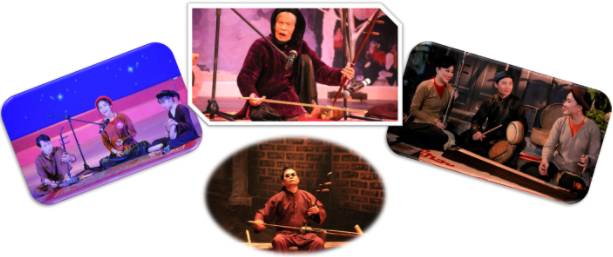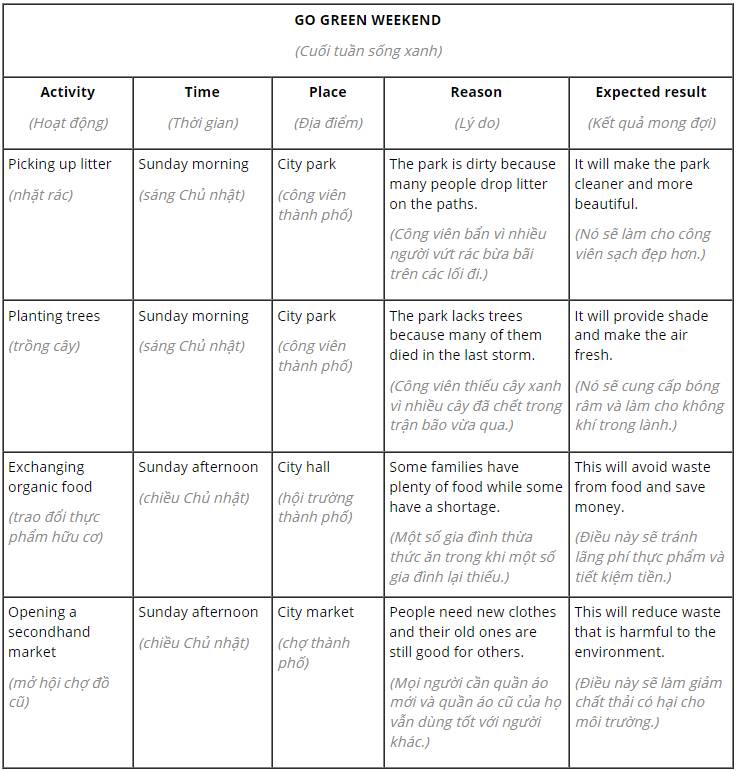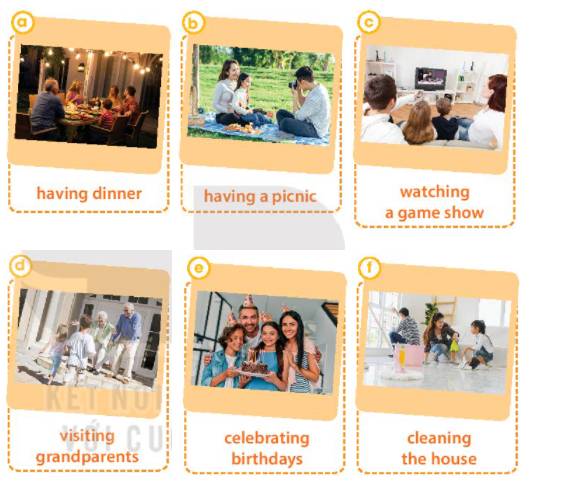Hãy nhập câu hỏi của bạn vào đây, nếu là tài khoản VIP, bạn sẽ được ưu tiên trả lời.

Xam singing (Hát xẩm)
1. When it started: the 14th century
(Thời gian bắt đầu: thế kỷ 14)
2. Instrument(s): monochord, two-chord fiddle, drum, clappers
(Nhạc cụ: đàn bầu, đàn fiddle hai hợp âm, trống, phách)
3. Types: 2
(Loại: 2)
4. Costumes: dark clothes, especially brown
(Trang phục: quần áo tối mào, đặc biệt là màu nâu)
We did research on a form of traditional music in Viet Nam which is xam singing. It is a type of Vietnamese folk music which was popular in the Northern region of Vietnam but is nowadays considered an endangered form of traditional music in Vietnam. The origin of xam singing was dated from the Tran dynasty in the 14th century. Xam artists often play monochord or two-chord fiddle to accompany the songs themselves, and sometimes they form a band with one singer and others who play traditional instruments such as the drum or clappers. If you search on the Internet, there are many different types of xam singing. However, depending on the rhythm of the drum, xam singing is divided into two styles, xam cho for a rapid rhythm and xam co dao for a slow one. About the costumes of xam performers, they often wear dark clothes, especially brown ones. After getting such information about xam singing, we hope that all of you will try listening to this ty

Tạm dịch:
Chúng tôi đã nghiên cứu về một loại hình âm nhạc truyền thống của Việt Nam, đó là hát xẩm. Đây là một loại hình âm nhạc dân gian Việt Nam phổ biến ở khu vực phía Bắc Việt Nam nhưng ngày nay được coi là một loại hình âm nhạc truyền thống có nguy cơ tuyệt chủng ở Việt Nam. Nguồn gốc của hát xẩm có từ thời Trần thế kỷ 14. Nghệ nhân Xẩm thường chơi đàn bầu hoặc đàn nhị để đệm cho các bài hát, đôi khi họ thành lập ban nhạc với một ca sĩ và những người khác chơi các nhạc cụ dân tộc như trống hoặc phách. Nếu bạn tìm kiếm trên Internet, có rất nhiều kiểu hát xẩm khác nhau. Tuy nhiên, dựa vào nhịp trống thì xẩm được chia thành hai kiểu, xẩm chợ cho nhịp nhanh và xẩm cô đào cho nhịp chậm. Về trang phục của người diễn xẩm, họ thường mặc đồ sẫm màu, đặc biệt là màu nâu. Sau khi biết được những thông tin như vậy về hát xẩm, chúng tôi hy vọng rằng tất cả các bạn sẽ nghe thử thể loại nhạc này.

Hello everyone, today I’m going to introduce to you our volunteer project named Happy Tutors. We are carrying out this project at Cau Giay District first and then we will open it at every district in Hanoi. Each volunteer in our team will become a tutor who is willing to help poor students study better. Students who have good results in any subjects can take part in our project. Our main activities are to make a list of poor students who need helps, find suitable tutors for them and assist them to study well. I hope our project will develop more in the future. If you are interested in our project, please send us your application soon.
Tạm dịch:
Xin chào các bạn, hôm nay mình sẽ giới thiệu với các bạn dự án tình nguyện mang tên Gia sư hạnh phúc. Chúng tôi đang thực hiện dự án này trước tiên tại Quận Cầu Giấy và sau đó sẽ mở rộng tại tất cả các quận của Hà Nội. Mỗi tình nguyện viên trong nhóm của chúng tôi sẽ trở thành một gia sư sẵn sàng giúp đỡ các học sinh nghèo học tập tốt hơn. Những học sinh có kết quả tốt trong bất kỳ môn học nào đều có thể tham gia vào dự án của chúng tôi. Hoạt động chính của chúng tôi là lập danh sách các học sinh nghèo cần giúp đỡ, tìm gia sư phù hợp cho các em và hỗ trợ các em học tốt. Tôi hy vọng dự án của chúng tôi sẽ phát triển hơn nữa trong tương lai. Nếu bạn quan tâm đến dự án của chúng tôi, vui lòng gửi đơn đăng ký sớm cho chúng tôi nhé.

I guess this woman is an astronaut. Her special helmet and some kinds of space machine like a rocket and a spaceship tell us about her job. The words in the picture look like Russian, so I think she comes from Russia.
(Tôi đoán người phụ nữ này là một phi hành gia. Mũ bảo hiểm đặc biệt của cô ấy và một số loại máy không gian như tên lửa và tàu vũ trụ cho chúng ta biết về công việc của cô ấy.Chữ trong bức tranh nhìn giống tiếng Nga nên tôi nghĩ cô ấy đến từ Nga.)

Tạm dịch:
A. Liên hợp quốc (UN) được thành lập vào năm 1945. Đây là một tổ chức của hầu hết các quốc gia trên thế giới. Mục tiêu chính của nó là hòa bình thế giới. Mặt khác nó cũng hoạt động để giảm nghèo và cải thiện cuộc sống của người dân. Việt Nam gia nhập tổ chức năm 1977. Kể từ đó, nước ta ngày càng năng động hơn và tham gia nhiều hoạt động của Liên hợp quốc trong đó có hoạt động gìn giữ hòa bình.
B. UNICEF được thành lập vào năm 1946. Tổ chức này hoạt động tại hơn 190 quốc gia để giúp cải thiện sức khỏe và giáo dục cho trẻ em. Nó đặc biệt nhằm hỗ trợ những trẻ em có hoàn cảnh khó khăn nhất trên toàn thế giới. Mục tiêu của UNICEF tại Việt Nam là bảo vệ trẻ em và đảm bảo chúng được khỏe mạnh, được giáo dục và an toàn không bị tổn hại.
C. UNDP được thành lập năm 1965 với tư cách là một bộ phận của Liên hợp quốc. Nó cung cấp hỗ trợ kỹ thuật, tư vấn chuyên gia và đào tạo để giúp người dân ở các nước đang phát triển có cuộc sống tốt hơn. Tại Việt Nam, UNDP phối hợp chặt chẽ với Chính phủ để xóa đói giảm nghèo và cải thiện đời sống của người dân.
D. WTO được thành lập năm 1995. Đây là tổ chức kinh tế quốc tế lớn nhất thế giới. Việt Nam trở thành thành viên WTO năm 2007. Từ đó đến nay, nền kinh tế nước ta đã đạt được mức tăng trưởng cao. Việt Nam cũng trở nên hấp dẫn hơn đối với các nhà đầu tư nước ngoài.

Everybody likes to watch TV and everybody has a favourite TV programme. I want to tell you about my favourite TV programme. I like to watch TV programme "Week of sports" very much, because I like sport. My favourite kind of sports is HOCKEY! I also like tennis and football. In this programme it is told about hockey, tennis. footbal and other kind of sports. That`s why I like it very much. It is told about all events of sports. "Week of sports" is very interesting and faseinating. I recommend to watch it.
I have told you about my favourite programme. Now I want to know about your favourite TV programme. What TV programme do you like? Why do you like to watch it?
Bạn có tham khảo ^^
Brighter Future "is a television program of my favorite. Program profound humanitarian, helping the unfortunate lives, wants children to get a home, a chance to go to school. Program as a bridge between the people to live in affluence with solitary children, disadvantaged ... It also brought a precious tradition of the nation: "Nhuong Com will dress". And particularly, it is also a chance for the young know look at the children in the program to strive for in life and learning.

1)History was my favourite subject in my academic year and I have learned so many things from the history books I read and learned from teachers related to history and they were so interesting that I later did my graduation majoring History.
Learning about the past history is something that gives us real knowledge about our country, the world and about the human race. I read History in my grade 7 and found it very interesting. This subject taught us about the past of your world, how the social and economic condition was and how the world has been shaped by the different events throughout the time. After that, I become so interested in this subject that I started reading books on History from different writers. There is a famous saying that "to shape the future you must know the past" and history teaches us that. I had been lucky to have some great teachers who have a tremendous way of explaining the topics of History. To me, other subjects like literature and Math were also interesting but I felt a different passion on History.
After I finished my school, I took History as my major and that has greatly influenced me the way I look at the world and to the past and future. Reading and learning history was like travelling through time and generations that excited me so much.
2)Would your students benefit from participation in a study group? Are you too busy to organize and supervise study groups for students in your courses? I’m guessing the answer to both questions is yes. If so, here are some ways teachers can encourage and support student efforts to study together without being “in charge” of the study groups.
Promote study groups – First, include a list of reasons why students should join study groups in the syllabus or on the course website. Maybe there’s a short podcast available in which you talk about the usefulness of study groups. Better yet, if you’ve got some students who studied together in a previous course, ask them to make some comments about their experiences. Second, talk regularly in class about study groups. You can repeat all the benefits, suggest activities that involve good group study strategies, or propose some things they could study together (like problems they could solve, questions they could discuss). You also can solicit feedback from study groups in class or mention content you discussed with a group during office hours.
Make study groups an option – Encourage students to organize their own groups, but offer to help with the process. Nudge them with reminders, such as “Send me an email if you’re interested in being part of a study group.” Have study groups “register” their members, and then report on meeting times and activities. Suggest study activities for the group (ideas like those offered in the next item). Invite the group to meet with you during office hours or to send questions electronically. Offer registered study groups that report regular meetings a bonus point incentive depending on the average of their individual test grades. Let all students know that joining a study group is an option throughout the course.
Demonstrate the value of a study group – Too often when students study together, it’s pretty much a waste of time. If they’re reviewing for a test, they talk about how it can’t possibly be that hard and thereby relieve themselves of the need to study. Or they “go over” their notes, reading what they’ve written but never with any discussion. Group studying is too often accompanied by eating, texting, and regular side conversations.
In order for students to get the most value from their study sessions, you’ll need to help them come up with a different set of strategies. You can do so by holding a review session and asking students to form potential study groups (it’s up to them if they want to meet as a group more often). Give the groups tasks like these: 1) For three minutes everybody reviews their notes and lists five things they think will be on the test and then for five minutes they share lists and create a group list of the items most often mentioned. During the exam debrief, students revisit their list of things they expected to see on the exam. Were those things on the exam? 2) Everybody takes three minutes and writes a question about some content they don’t understand or wish they understood better. The group devotes a specified amount of time to each question, looking for relevant content in their notes and the text. 3) The group has 20 minutes to make one crib sheet that everyone in that group can use during the exam.
Offer proof that study groups improve performance – Compare the scores, points, or grades of those working in study groups with those who aren’t. These are data which should be collected across several sections of the course.
Define study groups broadly – Students tend to think of study groups for exam preparation, but that isn’t the only kind of student collaboration that promotes learning. If there are regularly assigned readings for the course, students can get together to discuss the reading. Again you might let them do this first in class with a good set of prompts so they see how dialogue can enrich and deepen their understanding of the assigned material. Readings are easily discussed in virtual environments, which means the group doesn’t have to find a time when everybody can meet. If various writing assignments are required in the course, students can form peer editing groups. Rubrics, checklists, and prompts can help them get beyond superficial feedback (“you might need a comma here”) to the kind of helpful critique that improves the writing.
I usually get up at 5:30 in the morning. After washing my face and brushing my teeth, I do morning exercises for fifteen minutes. Then I have breakfast with Mum and Dad at 6:15 and leave home for school at 6:30. My classes start at 7:00 and end at 11:15. After that I go home, and have lunch with my family at 12:00. After lunch I usually have a short rest. I study my lessons , read books, and do homework from 1:30 p.m. to 4:00 p.m. I often play badminton with my friends on the ground at 4:30. I come back home and have dinner at 6:00 p.m. After dinner, I often watch the news on TV for thirty minutes. Then I prepare for the new lessons and go to bed at 10:30 p.m






We’re going to present some findings of our research on Family Day in Canada. Family Day is celebrated on the 3rd Monday of February and in this year 2022, Family Day is February 21st. First held in Alberta in 1990, Family Day was proposed by the province's former premier, Don Getty, after his son was arrested for dealing drugs. As we all know, family is not an important thing; it’s everything. Therefore, Family Day is supposed to reflect the values of family and home that were important to the pioneers who founded Alberta, and to give workers the opportunity to spend more time with their families. On Family Day, many people plan and take part in activities aimed at the whole family. These include visiting art exhibitions, watching movies, skating on outdoor ice rinks, playing board games, and taking part in craft activities. Some communities plan special public events, and art galleries and museums may have reduced price or free entry. These are all of our findings.
Tạm dịch:
Chúng tôi sẽ trình bày một số kết quả nghiên cứu của chúng tôi về Ngày Gia đình ở Canada. Ngày Gia đình được tổ chức vào Thứ Hai của tuần thứ 3 của tháng Hai và vào năm 2022, Ngày Gia đình là ngày 21 tháng Hai. Lần đầu tiên được tổ chức tại Alberta vào năm 1990, Ngày Gia đình được đề xuất bởi cựu thủ tướng của tỉnh, Don Getty, sau khi con trai ông bị bắt vì buôn bán ma túy. Như chúng ta đã biết, gia đình không phải là điều quan trọng; mà nó là tất cả. Do đó, Ngày Gia đình được cho là thể hiện các giá trị của gia đình và mái ấm quan trọng đối với những người tiên phong thành lập tỉnh Alberta, đồng thời mang đến cho người lao động cơ hội dành nhiều thời gian hơn cho gia đình của họ. Vào Ngày Gia đình, nhiều người lên kế hoạch và tham gia các hoạt động hướng đến cả gia đình. Chúng bao gồm tham quan triển lãm nghệ thuật, xem phim, trượt băng trên sân băng ngoài trời, chơi trò chơi trên bàn cờ và tham gia các hoạt động thủ công. Một số nhóm lên kế hoạch cho các sự kiện công cộng đặc biệt và các phòng trưng bày nghệ thuật và bảo tàng có thể giảm giá hoặc vào cửa miễn phí. Đó là tất cả những kết quả của chúng tôi.